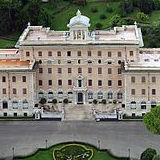
|
Vatican City Vatican City Last Updated: 09/09/2023 |
| Vatican City, officially known as the Vatican City State, is the smallest independent city-state in the world. It is an enclave within Rome, Italy, and serves as the spiritual and administrative center of the Roman Catholic Church. Its population was 764 in 2022. | |
| - Geography: Vatican City is located on the western bank of the Tiber River, within the city of Rome. It covers an area of approximately 44 hectares (110 acres), making it the world's smallest independent state both in terms of area and population. - Sovereignty: Vatican City is an independent city-state and sovereign entity recognized by the international community. It is the spiritual and administrative headquarters of the Roman Catholic Church and the residence of the Pope, the leader of the Catholic Church. - History: Vatican City was established as an independent state in 1929 with the signing of the Lateran Treaty between the Holy See -the ecclesiastical jurisdiction of the Catholic Church- and the Kingdom of Italy. Prior to that, the Papal States, ruled by the Pope, existed in the Italian Peninsula. - Religion: Vatican City is the spiritual center of the Catholic Church and is home to St. Peter's Basilica, one of the most important Christian pilgrimage sites. It is also the location of the Apostolic Palace, which includes the papal apartments, the Vatican Museums, and the Vatican Library. - Pope: The Pope, who serves as the leader of the worldwide Catholic Church, resides in Vatican City. The Pope is also the Head of State of Vatican City. Pope Francis has been the Pope since March 2013. - Government: Vatican City has its own government, with the Pope as the absolute monarch. The Pope's authority is exercised through various departments of the Roman Curia, which oversee different aspects of the Church's administration. - Economy: Vatican City has a unique economy primarily supported by contributions from the Catholic Church and tourism. It issues its own coins and postage stamps and has its own banking system, known as the Vatican Bank or the Institute for the Works of Religion. - Tourism: Vatican City is a major tourist destination, attracting millions of visitors annually who come to see St. Peter's Basilica, the Vatican Museums which house the Sistine Chapel with Michelangelo's famous ceiling, and other historic sites. - Cultural Heritage: The Vatican Museums contain an extensive collection of art and historical treasures, including paintings, sculptures, manuscripts, and artifacts from various periods of history. - St. Peter's Square: The iconic St. Peter's Square -Piazza San Pietro- in front of St. Peter's Basilica is a prominent gathering place and the site of many important religious events and ceremonies. - Diplomacy: Vatican City maintains diplomatic relations with numerous countries and international organizations. The Holy See, the ecclesiastical jurisdiction of the Catholic Church, is recognized as a sovereign entity in international law. - Language: The official language of Vatican City is Latin, although Italian is commonly spoken and used for official documents. Vatican City is a unique and culturally rich destination, with deep religious and historical significance for Catholics and people from around the world. It combines the spiritual importance of the Catholic Church with a rich cultural heritage, making it an extraordinary place to visit. | |
Wikipedia
Vatican City » Vcs
Place » City

|
St. Peter's Basilica Place » Temple St. Peter's Basilica, also known as Basilica di San Pietro in Italian, is one of the most renowned and iconic religious landmarks in the world. Located in Vatican City, an independent city-state within Rome, Italy, St. Peter's Basilica is known for its remarkable architecture, historical significance, and status as the largest Christian church globally. 202 views 💖 1Piazza San Pietro, 00120 Città del Vaticano, Vatican City |
Write a Review :
Vatican City
|
|